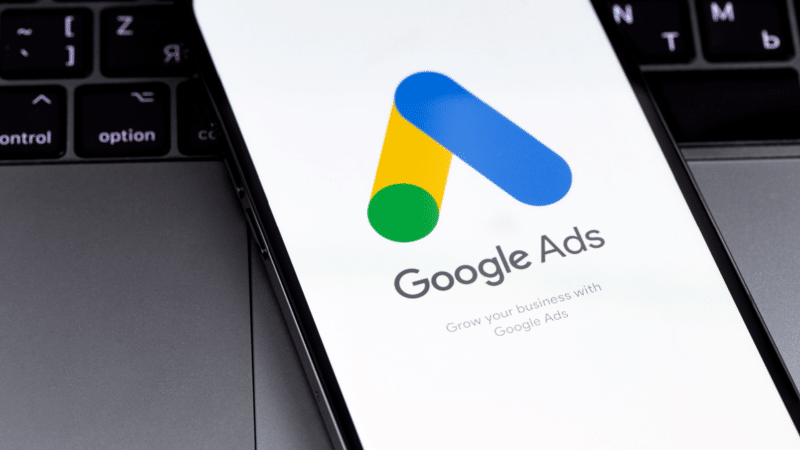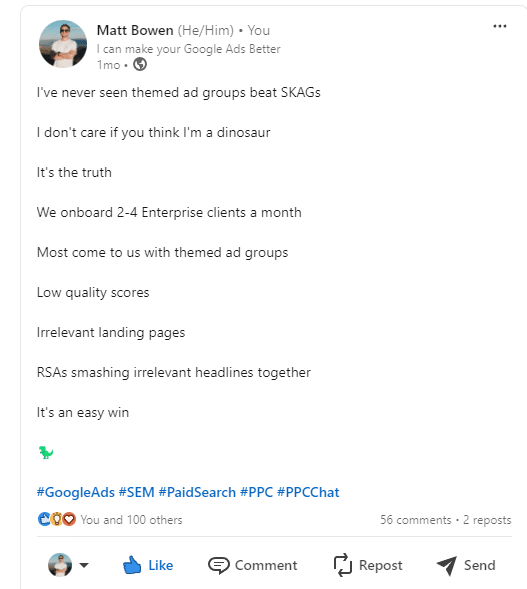
Interview 10 Google Ads experts and nine of them will tell you that themed ad groups (a.k.a. Hagakure) are the best way to build search campaigns.
I’m the 10th.
I’ve been publicly standing up for single keyword ad groups (SKAGs) for some time now – though I’ll admit it is a controversial take. Most recently, I posted this on LinkedIn:

I think the comment-to-like ratio tells the story of how well it was received.
Despite the controversy surrounding SKAGs, there’s a real opportunity for marketers to get more out of their Google Ads accounts with a SKAG approach.
A look at Google Ads account structures over time
From 2014 to 2018, most accounts we audited at my agency used ad group structures based on match type, device or SKAGs. By the latter half of this period and into 2019, SKAGs became the dominant structure.
A single keyword ad group is an ad group that contains only one keyword duplicated across multiple match types. Historically, this was exact, phrase and broad match modified.
In the modern era, a SKAG may or may not contain full broad match type depending on the account specifics.
This structure became so popular because it made keyword-stuffing ads simple. Given that the ad group only contained one keyword, the number of queries it was eligible for was small.
If Google Ads managers keyword-stuffed the headlines of the ad associated with the ad group, they could be confident that the ad would closely match the users’ queries.
This structure played Google’s Quality Score game better than the other structures. By ensuring “above average” ad relevance Quality Scores, CPCs went down and account performance improved.
However, SKAGs have always had detractors. The main complaint I’ve heard is that they are hard to manage and impossible to scale.
I believe this to be a bad objection. Our largest SKAG account has over 2 million keywords and we don’t find it difficult to manage. Even if we did, if it delivers even 1% better performance for clients – that’s our job. It’s our job to do hard things to get everything out of Google Ads possible.
Fast forward to today, Google Ads now integrates AI into its search products with:
- Responsive search ads (RSAs).
- Smart bidding.
- Broad match.
And some other big changes:
- Low search volume (LSV).
- Close match variants.
AI products like RSAs, smart bidding and broad match all came with the idea of “signal liquidity.” Anything algorithmic requires enough signal liquidity to learn and make good decisions.
This understanding led PPC marketers to think about how to structure their ad groups and campaigns to best provide Google’s AI with high-volume, high-quality information.
Meanwhile, LSV statuses meant many keywords stopped serving, moving those queries into Broad Match keywords. Close Match Variants meant queries weren’t as relevant to the keyword texts provided as they had been historically.
Many viewed the AI revolution combined with changes to matching as damaging to SKAGs.
The thinking went that if the value of SKAGs was closely matching ad groups to queries to enable higher ad relevance, then the broadening of eligible queries was surely negative for the strategy. Plus, if data volume matters, highly specific ad groups must be bad.
These changes, taken together, led people to develop two alternatives to SKAGs:
- Single theme ad groups (STAGs).
- Hagakure.
SKAG alternatives in Google Ads
Hagakure
Hagakure embraced the idea that signal liquidity was key to success. Popularized by an article on Think With Google, Hagakure is championed as the future of ad group and campaign structures.
The case study references increasing keywords by 10-fold and the number of ads by 30%, which “led to an almost 40% bump in overall conversions at the same cost of acquisition.”
The strategy recommends building as few campaigns as possible and including everything (even Dynamic Search Ads) in the campaign(s). The idea being this would maximize signal liquidity and get the most out of Google’s AI-powered ad tools like Broad Match and Smart Bidding.
STAGs
STAGs are a bit of a half measure. This structure lets ad groups balloon to many keywords as long as they closely follow a theme.
This ensures that ads are mostly relevant to the users’ queries (approximating SKAGs) while increasing click and conversion counts per ad group by increasing the keyword count and improving signal liquidity.
Why I still stand by SKAGs
Both of these Hagakure and STAGs seem promising, but I still advocate for SKAGs.
- I don’t build Google Ads accounts based on conjectures about signal liquidity.
- I don’t build Google Ads accounts based on what Google tells me to do.
- I don’t choose ad structures because they are easy.
I choose ad structures based on what works.
We’ve managed over 6,000 Google Ads accounts at my agency. I can see the POP search performance from accounts as they move from either Hagakure or STAGs into our SKAG approach.
SKAGs consistently win, and that’s all the argument I need.
But for those who want to understand the mechanism behind SKAGs winning, let’s go one level deeper.
The premise of SKAGs winning is that the ad relevance is better. This leads to higher Quality Scores and lower CPCs. This is still largely true.
Even with broad match, LSV and close match variants, the ad built for one keyword is still more relevant than the ad built for five.
Have broad match, LSV and close match variants made SKAGs today worse than SKAGs in 2019? Yes. But they still beat STAGs and Hagakure.
Meanwhile, the premise of STAGs/Hagakure working is signal liquidity.
Here’s the problem:
Signal liquidity matters only at the campaign level. That is where smart bidding is applied and where algorithms learn.
Addressing signal liquidity concerns
If you are concerned about signal liquidity (and you should be), ensure that enough SKAGs are contained within the campaign that you’re reaching at least 30 conversions per month, ideally 100.
If you’re still skeptical, I’d recommend this:
- Pull in ad relevance scores at the keyword level.
- Filter for all ads rated “below average.”
Moving that to an “average” rating should increase Quality Score by ~3 points, which will reduce CPCs by 30%.
If all keywords currently rated below average saw a 30% drop in cost for the same click and conversion volume, what impact would you have on your account?
I’d bet that number makes you think it’s at least worth a test.
source https://searchengineland.com/why-single-keyword-ad-groups-still-matter-in-2024-444260

0 Comments